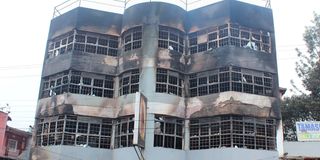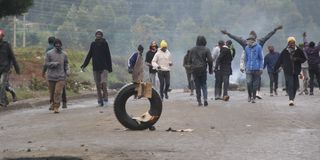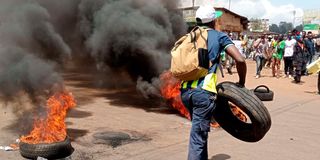
What remains of the building that hosted Magunas Supermarket in Makutano town, Meru County. The building was set on fire by protesters on July 7, 2025.
Towns in Mt Kenya, long known as oases of peace, have become epicentres of politically-driven violence in recent months.
Towns in Meru, Tharaka Nithi, Embu, Nyeri, Laikipia, Nyandarua, Murang’a, Kirinyaga and Kiambu counties have only experienced brief unrest over issues like illicit liquor or local development concerns in the past.
That has changed. Violence and destruction have erupted in Makutano (Meru), Nyahururu and Nanyuki (Laikipia), Karatina (Nyeri) and Murang’a, Kangari, Kabati and Kenol in Murang’a County.
Mayhem has also been witnessed in Ngurubani, Kagio, Sagana (Kirinyaga), Ol Kalou, Ndunyu Njeru and Engineer (Nyandarua) as well as Embu and Kiritiri in Embu County.
Ruiru, Ndumberi, Makongeni and Thika in Kiambu have also seen violence, with observers saying political chaos may soon be a trademark of the region.

Protesters barricade a section of the Nyeri-Nairobi highway in Karatina town, Nyeri County, during the Saba Saba protests.
“People in Mt Kenya used to protest against illicit alcohol and illegal dumping. These were causes aimed at improving their well-being,” Prof Peter Kagwanja, a political commentator, told the Daily Nation.
“We are now witnessing the destruction of property, battles with police, looting and even murder.”
He added that past confrontations between residents and security agents were over the war on Mungiki gangs, vigilantes or mob justice.
“We are in the ugly era of people destroying businesses, burning police stations and forcing economic shutdowns,” he said.
While leaders and security agents trade blame, the underlying causes appear to be linked to the General Election in 2027.
Ms Annabel Njambi, the owner of County Supermarket in Murang’a, says she lost more than Sh200 million when her four branches were looted on Monday.
“The gangs must have been sponsored. They descended on our headquarters in Kenol and branches in Kagio, Kabati and Kagumo. Police officers did nothing. It’s not hard to see the plot and who’s behind it,” she said.
Rwathia Distributors Director, Kanene Kabiru, said the region is being “economically crucified by a political elite in disarray”.
“Protesters have genuine grievances that must be addressed, but not by burning what little economic life remains,” he said.
“President Ruto must know that securing the country is his responsibility. The opposition will naturally try to derail him. That is politics. It is the duty of the government to ensure protests don’t descend into violence.”
Central Region Acting Commissioner, Joshua Nkanatha, said what began as genuine protests has been hijacked by criminals.
“This is not in the spirit of Mt Kenya. We are not known for destroying our livelihoods. Let it be known that the government is doing all it can to restore order,” Mr Nkanatha said.
Ol Kalou town is arguably the land of milk and honey, surrounded by farming neighbourhoods.
The mention of Ol Kalou, which is also the Nyandarua County headquarters, evokes images of abundance.

A protester lights a bonfire in Embu town on December 27, 2024. Residents were protesting the abduction of a student, Billy Munyiri Mwangi.
However, recent youth-led protests have thrust this typically quiet and little-known town into the limelight, revealing a dark undercurrent its lush fields and the seemingly contented faces of residents.
On June 25, Ol Kalou was in the national headlines when rowdy youths stormed county and national government offices, setting them ablaze and destroying property estimated at Sh200 million.
The protests, which marked the first anniversary of the 2024 anti-Finance Bill demonstrations, turned violent.
Angry youth set on fire 26 vehicles, motorcycles and government buildings.
The devolved government reported that new music equipment stored at sub-county offices was also destroyed.
Saba Saba Day protests began well in Ol Kalou on Monday, before quickly turning violent.
Young people engaged police officers in running battles, lit fires and barricaded roads, bringing activities in the town to a standstill.

A protester stokes the flames of a bonfire lit by protesters on the Nyeri–Nairobi highway in Karatina town during the Saba Saba protests on July 7, 2025.
Overwhelmed by police, the protesters retreated to nearby shopping centres like Mairo-Inya and Gwa Kungu where they forced businesses to shut.
They exploited the absence of police in these small towns as almost all officers had been deployed to Ol Kalou and Nyahururu.
Bees as arsenal
According to Mr John Maina, 79 – a longtime resident – Ol Kalou appears to be stepping in the shoes of Nyahururu, which is historically known for political defiance and unrest.
“Nyahururu was a hotspot during the fight for multiparty politics. It was here that attacking police officers with bees was first tested – and it worked. Protesters used containers of bees and hives as weapons. In fact, President Moi was worried about the path Nyahururu was taking,” Mr Maina said.
“Ol Kalou could be following in the footsteps of Nyahururu, which has become calm and cosmopolitan.”
Mr Francis Kimani, a religious leader in Ol Kalou, attributes the rising tension to local political figures encouraging young people to adopt radical positions.
“Like in the 1990s when Nyandarua had radical politicians, the current leaders – especially those in the opposition – are influencing the youth to be defiant,” Mr Kimani said.







